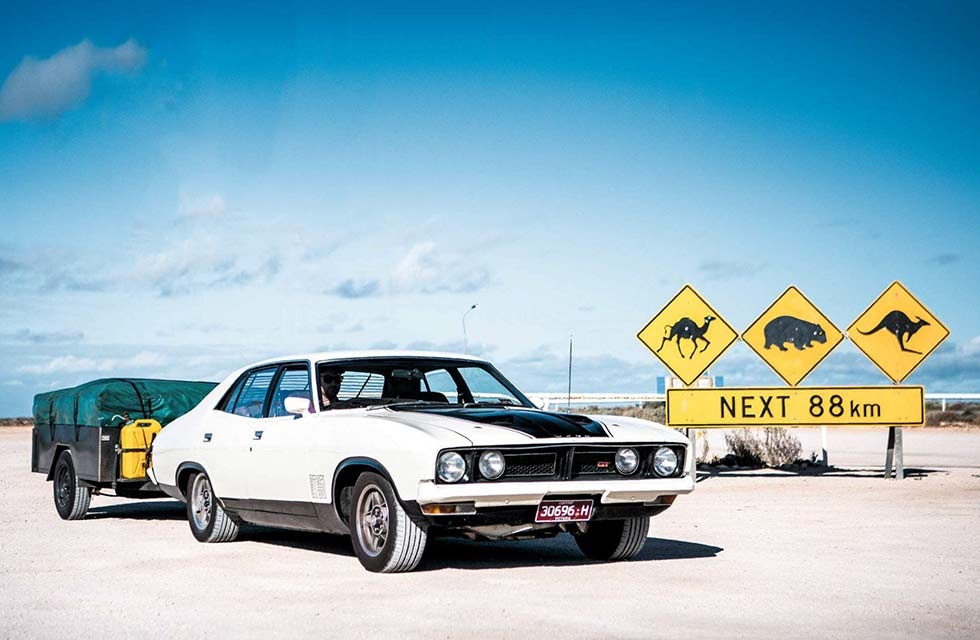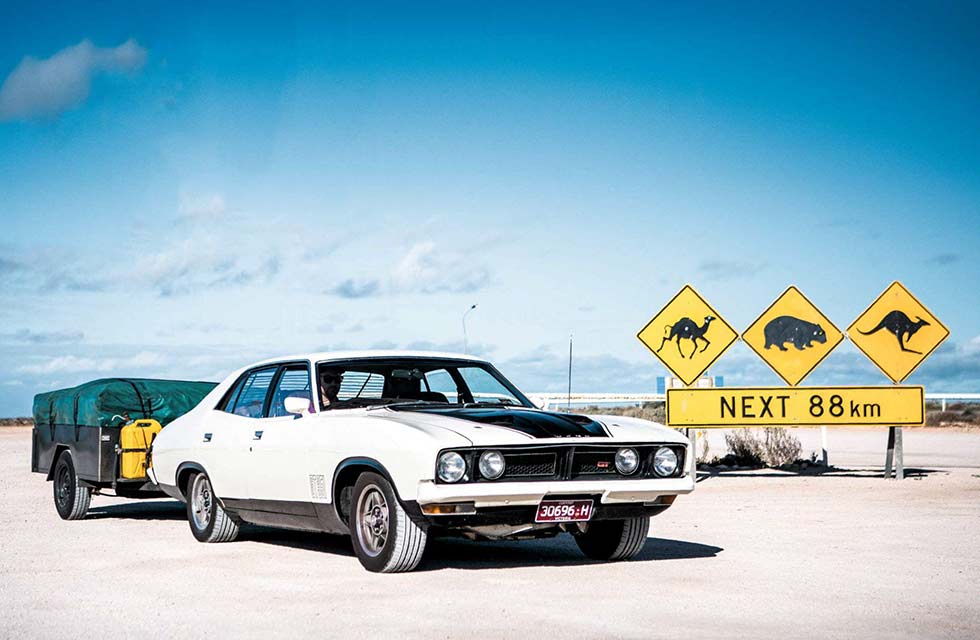
4000 Miles of Aussie Dust Melbourne to Perth through the unforgiving Outback in an Australian muscle-car legend – the Ford Falcon XB GT. Can a Seventies muscle car survive 4000 miles of searing Outback heat? One Ford Falcon GT, four mates and 4000 miles of trans-Australian tarmac. Let the adventure begin Words Stewart Perry. Photography Ross Perry.
4000-mile Aussie road trip by 400bhp Falcon
Storming great distances across Australia’s stark landscape in a big, brash V8-powered muscle car at speed with your mates was a way of life for a generation of Australians. Being too young to experience this in its heyday of the late Sixties/early Seventies, my brother Ross and I, with good friends Mick and Heath, jump at our chance to recreate history. In my 1974 Ford Falcon XB GT with 230,000 miles we’re setting of on the quintessential road trip, 2500 sparsely inhabited miles across the continent from Melbourne to Perth. Our mission – to attend the Falcon GT Nationals meeting, a biennial gathering of hundreds of cars from across Australia that rotates between major cities, and starts in one week’s time. The GT’s 351 cubic inches (5.8 litres) of Cleveland V8 roars to life and settles into a mild throb as we point the big machine into the miserable Melbourne rush-hour traffic.

With four passengers, luggage, and a small camper trailer in tow, we’re heavily laden. This, combined with the four-speed Toploader gearbox’s tall 2.78 first gear, and the factory 3.0 axle ratio specified for high speed touring – and top speed at Bathurst racetrack – necessitates slipping the clutch to keep pace with the crawling line of commuters. An hour and a quarter later, we finally settle on a easy 70mph cruising speed with the quad seven-inch headlights shining our path, and rumble into our first camping stop well after midnight.
Playing Seventies Aussie rock music through the very Nineties Alpine stereo, we strike out next day into northern Victorian desert terrain – an early taste of the flat, dry horizon that will be the norm for many days to come.
Covering highway miles, the GT is in its element. Despite no overdrive, it’s turning only 2700rpm at 70mph and on a light throttle the exhaust note is a gentle background thrum almost hidden by wind noise. Road noise is sufficiently low for happy radio listening and talking without yelling – a blessing when faced with 40 hours confined in close proximity in the cabin.
‘The GT devours the miles with ease, even if a little slower than its designers intended’
By 10am the harsh sun is starting to heat up the car, and the wall-to-wall brown vinyl isn’t helping. Luckily, the XB has the optional factory-installed air conditioning, so with a couple of clicks of the controls and a slight chirp from the belt as the twin-piston York compressor cuts in, refreshing chilled air starts to low. Just on sunset, as we arrive in Port Augusta with 400 miles down for the day, idle quality has noticeably deteriorated. I thought I’d licked this niggling problem before we left, but it’s resurfaced – the extra load of running the aircon probably hasn’t helped.
Our third day sees us traversing a red dirt landscape of iron ore country en route to the sparkling blue of the Great Australian Bight at the commercial fishing township of Ceduna. Ahead of us now is the heart of our adventure – the true wilds of the Nullarbor (literally ‘no trees’) Plain. Save for a basic roadhouse every couple of hundred miles there is no fixed habitation, with the next major township of Norseman over 750 miles away. And calling Norseman a major town is a stretch; boasting a population around 1000 it’s merely more substantial than anywhere else we’ll encounter in the next few days. The lack of civilised comforts is driven home when, not far out of Ceduna, we lose all phone reception – not to be regained for another two days. It’s reinforced when we come across our first set of runway markings – urgent medical needs in the outback have to be attended by the Royal Flying Doctor Service, and because of the lack of handy airfields, emergency landing strips are marked at intervals on the main highway!
The GT devours the miles with customary ease, even if for the most part a little slower than its designers intended. Draconian enforcement of speed limits rules out cruising at high speed these days, at least without risking an expensive ticket. Although the Eyre Highway is the only major road within 1500 miles it’s still only one lane either way. Thankfully for us overtaking is a breeze because aside from a plethora of (painfully slow) caravans accommodating Australia’s tribe of ‘grey nomads’ wending their way through retirement, massive road trains are a common sight. These are prime movers with triple trailers (maximum length 175 feet) and top speeds limited to 62mph rather than the 70-odd we’re doing, and understandably require quite a bit of space to get past. In fairness the GT’s motor is not quite standard, with some mild breathing modifications carried out when I rebuilt it a few years back, freeing up around 100bhp without substantial impact to its mild character or fuel mileage. Click the shifter into third, roll on the throttle, and a confident surge towards the horizon is accompanied by a pleasing roar from the twin 2½in exhausts. By the time we draw level with the road train cab the tachometer needle is rapidly approaching the 6000rpm redline, and it’s time to shift into fourth just as the speedometer crests 100mph.
Desolate scenery aside, the Nullabor boasts a number of offbeat features. Among them is the world’s longest golf course, which stretches 855 miles – and Mick is determined to play as many as possible of its 18 holes. Another record is the longest piece of straight road – over 90 miles with no need to slow for even the slightest deviation. Regardless, regular teeing-of means we are still 50 miles from the next roadhouse as darkness starts to descend. We discount the hazard of wandering feral camels, but the risk of hitting native wildlife is very real because the animals scout for food after the day’s heat. Kangaroos have a propensity to hop unpredictably into the path of vehicles, as abundant roadkill testifies).
I slow to 50mph, which feels like a crawl, and indeed it’s not long before we spot mobs of kangaroos and emus. Fortunately, no close calls, and with relief we reach the Western Australian border roadhouse. Pulling into camp, the GT’s headlights effectively illuminate my teenage dream car – a 1969 Ford Falcon XW GT painted Starlight Blue. Before we even have our tents up, its owners come over to say hello and chat about our respective progress.
Day five, and we decide to push on for another 450 miles (once more with mandatory golfing stops) to arrive in Norseman at sunset, looking forward eagerly to a shorter day’s travel tomorrow. We immediately spot a Ford Galaxie complete with a period caravan in tow, and it doesn’t take us long to introduce ourselves. Sharing a BBQ we learn it’s a ’1964 model powered by a 390 FE big block, also heading west from Victoria albeit at a slightly more leisurely pace. There’s nothing like covering thousands of miles on largely vacant roads to foster instant camaraderie between fellow travellers, especially car enthusiasts.
At this point we eschew the most direct inland route to Perth for a change of scenery and a swim at Esperance’s pristine white sands on the coast 160 miles to the south, followed by a generous tasting at the local brewery. The GT still isn’t idling well and now the overall running is an issue, so I bite the bullet and it new spark plugs at breakfast next morning while the engine is still cold. This seems to ix the problem, at least for now. Changing plugs on the right bank is easy, but the left is very challenging to do without drawing blood, or prior training as a contortionist.
Next up Albany, an early military outpost and whaling station, and our final stop before Perth. Despite multiple local attractions, we can’t linger and have to straightline it to make in time for Falcon GT Nationals scrutineering – strictly no replicas are allowed. The event will take us through three fascinating days of car displays with 200+ other Falcon GTs, outings in convoy driving the Perth hinterland, and a visit to an amazing private Ford collection housing at least 100, mostly Australian, models.
But first, a thorough clean is in order. The high-pressure hose of a commercial carwash is critical to shift layers of dead bugs, followed with a detailed clean and wax. Mick even does the engine bay, a treatment the GT isn’t used to. Previous GT Nationals have included motor sport, but disappointingly nothing is organised this time – I’d much rather experience these cars at full noise than in a static show. To make up the deficit, as part of a post-Nats extended holiday taking in the Margaret River wine region, we decide to incorporate a track day at Collie Motorplex. It’s a joint effort between the Porsche club of WA and the Holden Special Vehicles club, and on arrival we’re pleased to see an eclectic mix of everything from Triumphs to Alfa Romeos.
Save for a rear anti-roll bar and uprated front anti-roll bar, the XB is stock. While it’s no purpose-built sports car, it belies its family-car roots and weight on the track, proving surprisingly handy. It has ample power, good brakes, and while it rolls around a little, it’s very predictable in response – some understeer on the limit progressing to power oversteer with a liberal throttle application. The biggest letdown is the power assisted steering; great at slow speeds, but it lacks feel for performance driving.
Disappointingly, our day is marred by minor mechanical dramas. Firstly, the ongoing ignition issues cause the engine to fall flat above 4500rpm, necessitating a stop to cool down enough to change plugs again. With that resolved we pick up the pace, but it quickly becomes evident we have a brake issue not apparent at road speeds. The pads in the car are an aggressive street/mild track compound that really bite when hot, and by the second lap at full pace are shuddering violently. The bonnet dances around visibly, though thankfully the factory-fitted hood pins reassure me that it isn’t going to come loose. Frustratingly, it stops me testing the car’s limits any further, but despite the setbacks it’s fantastic to drive a new track.
Pressures of real life necessitate freighting the car home and lying back for work on Monday. In truth, while driving the Nullarbor is a great experience, once is probably enough in such a short time. From the coastal town of Bunbury, around 100 miles south of Perth, we’re on the road early to drop the car at the freight depot and head to the airport. For old time’s sake we make one last stop in the Hillman suburb where the GT was delivered new in 1975. As we pull up, the current homeowner emerges for a chat. It turns out he’s a car buff with his own Leyland P76 V8, and bought the house from my car’s original owner – handy because he helps me trace the car’s history.
As we go to leave I attempt to select first and realise I can’t. Minor panic ensues because we can’t afford to break down now with only just enough time to catch our light. I gingerly reach under the car, avoiding the hot exhaust, to try fiddling with the external shift linkages. But given the GT’s low slung body I can barely reach them. In desperation I jump back in to try letting the clutch out to see what gear we’re stuck in. It seems to be third, and despite the trailer’s weight the car pulls away – thankfully there’s plenty of torque just of idle. It’s not ideal, but we decide to search for somewhere we can gain better access. A shopping complex with tall gutters enables us to park on the tilt providing enough space to get a decent grip and free the linkages. We make the dash to the freight depot and airport with a few minutes to spare.
In 19 days our 43-year-old grand tourer has covered almost 4000 miles, crossed an arid continent, shone on display, and even hit the racetrack, all with only minor grumbles. The XB GT has lived up to Ford’s period slogan ‘The Great Australian Road Car’.
TECHNICAL DATA FILE SPECIFICATIONS 1974 Ford Falcon XB GT saloon
Engine 5752cc V8, ohv, Ford Autolite ‘4300’ 605cfm four- barrel downdraught carburettor
Power and torque 300bhp @ 5400rpm SAE (gross) (400bhp @ 6000rpm DIN nett as tested); 380lb ft @ 3400rpm
Transmission Four-speed manual, rear-wheel drive
Steering Power-assisted recirculating ball
Suspension Front: independent by double wishbones, coil springs, anti-roll bar. Rear: live axle, leaf springs, radius rods (anti-tramp)
Brakes Ventilated discs all round
Weight 1587kg (3500lb)
Performance Top speed: 120mph; 0-60mph: 8.1sec
Fuel consumption 18-23mpg
Cost new $5200 AUD (around £3300)
Classic Cars Price Guide £25,000-£35,000
‘In my Ford Falcon XB GT we’re setting forth on the quintessential road trip across the continent’
Making history: Ford Falcon XB GT halfway across a continent en route to the Falcon GT National meeting. Falcon needed two new sets Quad headlights – of spark plugs Ideal for country night time driving Sign of things to come: 4000-mile road trip across Australia means a lot of sky Fellow Falcon enthusiasts in their 1969 XWGT also heading to the Nationals.
The band of brothers brace themselves for 40 hours cocooned in brown vinyl. The 351ci (5752cc) V8 proves ideal for highway cruising. XB GT proves handy on the track despite being more of a Grand Tourer than its homologation-special predecessors. V8 is a 351 cubic inch motor (5.8 litres) delivering 300bhp in standard form. Its 380lb ft of torque helps 1587kg of the line. Alpine stereo delivers Seventiess Aussie rock. Falcon GT makes easy prey of triple trailer road trains and tribes of grey-haired nomads with their caravans. Trains, trams and Falcon. Know what we’d take. Front and rear anti-roll bars help control the beast. Minor tuning has freed up an additional 100bhp from the Cleveland V8. Twin 2½in exhausts provide the thunder. The Falcon takes a well-deserved rest at the waterside in Port Augusta.
‘While driving the Nullarbor is a great experience, once is probably enough in such a short time’
THE FALCON XB GT’S RACING ROOTS
In its early years the Australian Falcon GT (produced 1967-1976) was used by Ford to homologate the car for the Bathurst 500 production race and Australian Touring Car Championship, requiring 300 to be sold to the public.
In 1972 the Sydney Sun Herald announced ‘160mph “Super Cars” Soon’, foreshadowing plans for the big three (Ford, Holden and Chrysler) to release even faster homologation specials onto the roads. In response, the Australian Government threatened to cancel its leet contracts, and so died the ultra-high output models.
Sports Car World summed up the change for the GT, introducing the XB series in 1974 with the headline ‘Ford Reines the Stormer.’ The GT became truly a Grand Tourer, rather than a touring car for the road.
A Ford Falcon XR GT at Bathurst in 1967.






